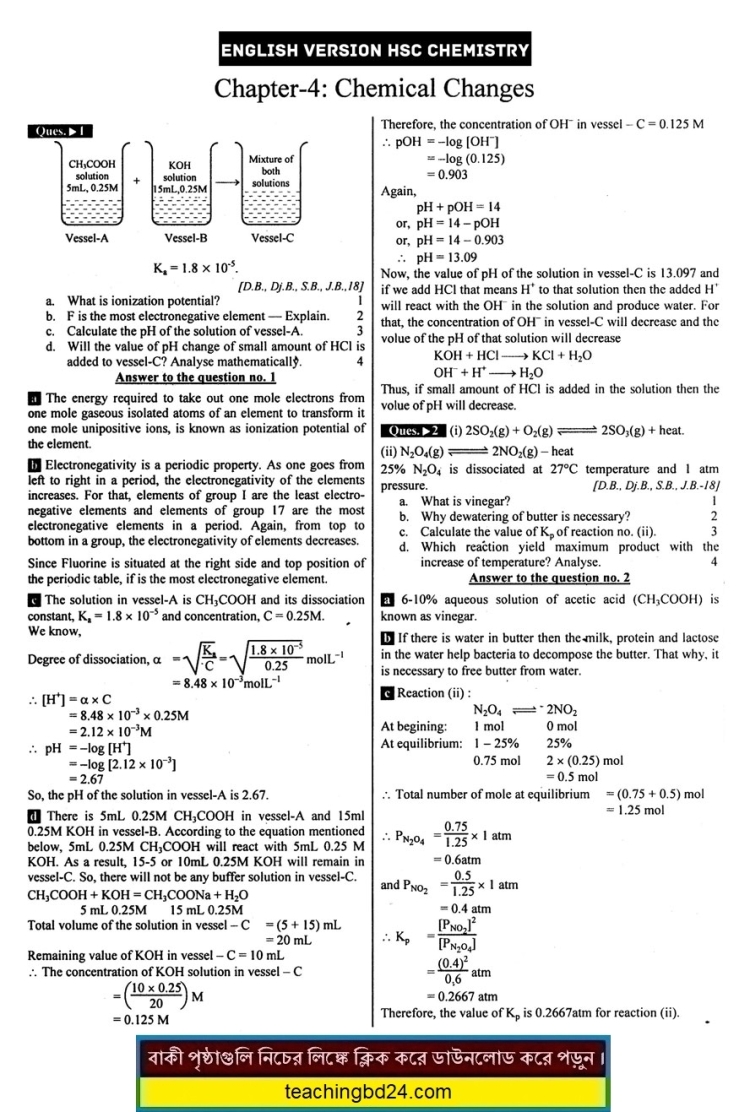HSC EV Chemistry 1st Paper 4th Chapter Note
HSC EV Chemistry 1st Paper 4th Chapter Note. Periodic Chemical Changes. Chemical changes occur when a substance combines with another to form a new substance, called chemical synthesis or, alternatively, chemical decomposition into two or more different substances. These processes are called chemical reactions and, in general, are not reversible except by further chemical reactions. Some reactions produce heat and are called exothermic reactions and others may require heat to enable the reaction to occur, which are called endothermic reactions. Understanding chemical changes is a major part of the science of chemistry.
HSC EV Chemistry 1st Paper 4th Chapter Note. Periodic Chemical Changes



The classical procedure for the complete systematic analysis of an inorganic sample consists of several parts. First, a preliminary dry test may be performed, which may consist of heating the sample to detect the presence of such constituents as carbon (marked by the appearance of smoke or char) or water (marked by the appearance of moisture) or introducing the sample into a flame and noting the color produced. Certain elements may be identified by means of their characteristic flame colors. After preliminary tests have been performed, the sample is commonly dissolved in water for later determination of anionic constituents (i.e., negatively charged elements or groupings of elements) and cationic constituents (i.e., positively charged elements or groupings of elements).
The procedure followed is based on the principle of treating the solution with a succession of reagents so that each reagent separates a group of constituents. The groups are then treated successively with reagents that divide a large group into subgroups or separate the constituents singly. When a constituent has been separated it is further examined to confirm its presence and to establish the amount present (quantitative analysis). Portions of the material are dissolved separately, and different procedures are used for each to detect the cationic and anionic constituents
In many countries, laboratory work is subject to health and safety legislation. In some cases, laboratory activities can also present environmental health risks, for example, the accidental or deliberate discharge of toxic or infective material from the laboratory into the environment. All students must read and understand the information in this docomeent with regard to laboratory safety and emergency procedures prior to the first laboratory session. Your personal laboratory safety depends mostly on YOU. The effort has been made to address situations that may pose a hazard in the lab but the information and instructions provided cannot be considered all-inclusive.
With good judgment, the chance of an accident is very small. Nevertheless, research and teaching workplaces (labs, shops, etc.) are full of potential hazards that can cause serious injury and or damage to the equipment. Working alone and unsupervised in laboratories is forbidden if you are working with hazardous substances or equipment. With prior approval, at least two people should be present so that one can shut down equipment and call for help in the event of an emergency. Safety training and/or information should be provided by a teaching assistant, technician, or staff member at the beginning of a new assignment or when a new hazard is introduced into the workplace.
teachingbd24.com is such a website where you would get all kinds of necessary information regarding educational notes, suggestions and questions’ patterns of school, college, and madrasahs. Particularly you will get here special notes of physics that will be immensely useful to both students and teachers. The builder of the website is Mr. Md. Shah Jamal Who has been serving for 30 years as an Asst. Professor of BAF Shaheen College. He expects that this website will meet up all the needs of Bengali version learners /students. He has requested both concerned students and teachers to spread this website home and abroad.
